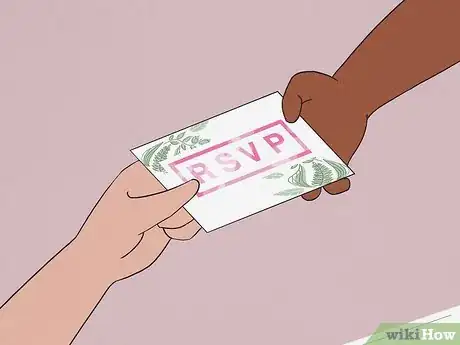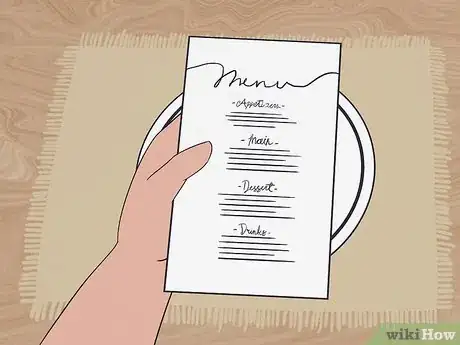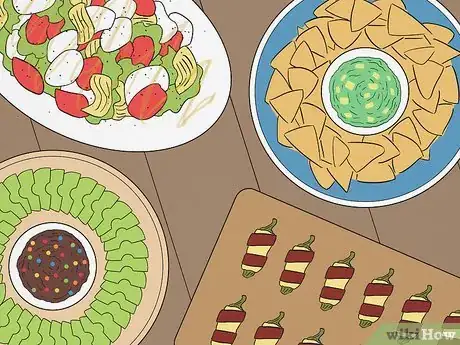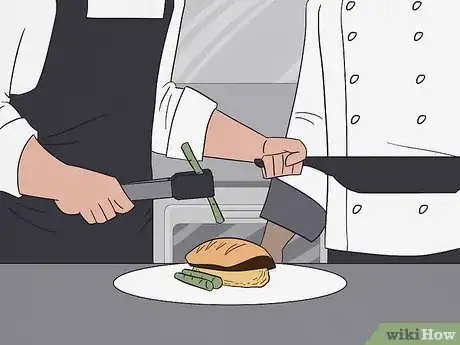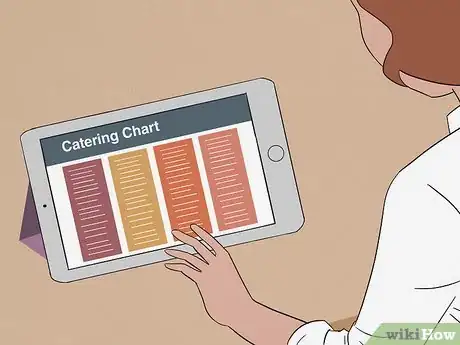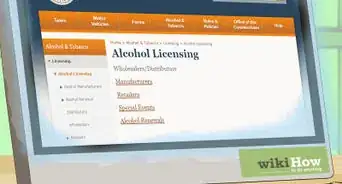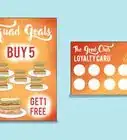This article was co-authored by Natasha Miller. Natasha Miller is an Event Planner, Chief Experience Designer, and President of Entire Productions, an event and entertainment production company based in San Francisco, California. Notable clients Natasha has collaborated with include Apple, Google, Gap, Louis Vuitton, Tiffany & Co., and Salesforce. Natasha and Entire Productions has been awarded Inc. 5,000's "Fastest Growing Companies in America", Entrepreneur Magazine's 360 List of "Best Entrepreneurial Companies in America." Entire Productions is also a Certified Women Business Enterprise. Natasha is a member of Meeting Professionals International (MPI).
This article has been viewed 32,256 times.
If you're catering an event and want to plan out how much food will be served, there are some simple ways to get an accurate estimate. The first step is getting a head count of how many people will be attending the event. If you're serving a sit-down meal, each person will eat 1 portion of food, while a buffet will require a little bit more food due to people serving themselves. By selecting the drinks, appetizers, main dishes, and desserts you'll offer, you can calculate how much of each food to serve so that you're sure not to run out.
Steps
Figuring out Event and Food Logistics
-
1Get an estimate of how many people will be attending the event. The first step to figuring out how much food will be needed at a catered event is to find out how many people will be attending. The best way to do this is to ask everyone to RSVP, giving them a deadline to submit their response by.[1]
- While it’s still possible that the number of people attending will change whether they RSVP or not, this is still a super helpful way to estimate how much food to purchase.
- If you’re catering someone else’s event, ask them to set a deadline for people to RSVP so that you can get an accurate head count.
-
2Prepare more food for a sit-down meal than an event with just appetizers. Since a formal sit-down meal includes several different courses with pre-planned portions, you'll need to purchase more food for this kind of event than you would an informal gathering. Plan out the courses of your meal, if any, as well as any appetizers you'd like to serve.[2]
- For example, a casual birthday party might have trays of appetizers or easy snacks to pick up, while a wedding reception would entail a sit-down dinner.
- Overall, people tend to only eat 1 serving of each food at a formal event like a sit-down meal, while more informal events where people can eat as much as they’d like might cause people to go back for seconds.
- Ask your caterer for a recommendation, too. They can provide a good estimate about how much food you'll need for the event.[3]
Advertisement -
3Expect to serve more food if the event is during a mealtime. If the event is during a mealtime, like breakfast, lunch, or especially dinner, people will expect to be served a full meal’s worth. If your event is at an off time, such as the middle of the afternoon or late at night, snack-size portions will work well to feed everyone.[4]
- For example, a party that’s set to happen between 6 pm and 9 pm should have more food prepared than a party happening from 3 pm to 5 pm.
-
4Decide on a diverse menu to give the guests a wide variety of options. Instead of purchasing large amounts of just a couple different foods, opt for bulk amounts of a wide variety of choices so that everyone gets something that they like. If you’re catering for someone else’s event, ask them if they have any food requests, such as dishes they definitely want to serve or things they'd like to have extras of.[5]
- Plan meals for people with food restrictions or allergies in case someone can't eat the main meal or appetizers.
-
5Purchase extra cheap foods if you’re worried about running out. Foods like potatoes, bread, and salad are great fillers and don’t cost very much, making them good options for foods to purchase as back-up portions. Stock up on a few of your cheapest side dishes or snacks so you don’t have to worry about not having enough food.[6]
Estimating Food Portions Per Person
-
1Have enough drinks available for each guest to have 1-2 per hour. For non-alcoholic drinks like soda or water, plan on each person having 2 drinks in the first hour and then 1 drink every hour after that. If you’re serving alcohol, purchase enough to allow each guest to have 1 drink every hour. While it’s not necessary to have a ton of different drink options, make sure you have a small variety such as water, soda, or juice for non-alcoholic beverages and wine, beer, and a small selection of cocktails for alcoholic beverages.[7]
- If you’re catering a children’s party, you might have things like juice boxes, water, chocolate milk, or non-caffeinated sodas.
-
2Prepare 3-4 appetizers per person per hour if a sit-down meal is later. Smaller snacks or appetizers, which each count as 1 bite for a serving, can be determined by how many each person will likely eat each hour. If you’re serving appetizers before a meal, each person will eat roughly 3-4 of these each hour. By multiplying this number by how many people are attending and how many hours the event will continue, you can determine a rough number of how many appetizers will be needed.[8]
-
3Plan for each guest to eat 8-10 appetizers per hour during a meal time. If you're not serving a sit-down dinner but want to feed your guests during breakfast, lunch, or dinner time, have enough hors d'oeuvres for each person to have at least 8 per hour. Multiply this number by the number of people attending as well as the number of hours the event will continue for, and you have your appetizer estimate.[9]
-
4Offer 1 portion of each food per person for a sit-down meal. Main courses, such as meat, fish, or pasta, will require a larger portion size than a side dish like potatoes or rice. Look up each food you intend to serve's portion size and multiply this by the number of people attending the event to find out how much food you'll need.[10]
- For example, each person should be served 225 grams (7.9 oz) of meat, 60 grams (2.1 oz) of vegetables, 115 grams (4.1 oz) of potatoes.
- Other sides might include 30 grams (1.1 oz) of rice, 300 millilitres (20 US tbsp) of soup, or 30 grams (1.1 oz) of cheese.
- If you're not sure what the portion size is of a certain food, type "green beans portion size" or something similar into an online search engine.
-
5Overestimate how much food will be eaten if you're having a buffet. Since people are able to choose their own portions at a buffet, it's likely that more food will be consumed than if you were planning a sit-down dinner. Instead of just planning on each person having 1 serving of each item, estimate that they'll have 1-2 servings each.[11]
- Keep in mind that they more options you have, the smaller the portions will be as people will likely want to try a small amount of each food.
-
6Give each person 1 serving of dessert if a full meal will be served. On average, a slice of cake per person or 2 bite-size portions of dessert is perfect for an event where more hearty foods will be served. Find out how many people will be attending the event and prepare this same number of desserts for your guests.[12]
- If you'd like to be on the safe side, multiply the dessert amount by 15-20% in case anyone wants seconds.
-
7Have 4-6 desserts prepared per person if you're planning a dessert party. If it’s an event centered around desserts or is taking place after a meal, you’ll want to provide more servings than an event where lots of other foods are served. Plan to have 4-6 small dessert servings for each person throughout the whole event.[13]
- These could be things like bite-size cupcakes, cookies, or brownies.
-
8Refer to catering charts if you’re not sure of certain quantities. There are lots of catering charts online that show you how much of each type of food to serve when catering a group of people. Look at one of these charts for ideas about how much food to serve per person, or look up a specific food that you’re planning on making to find the precise serving quantity.[14]
- For example, type “appetizer catering quantities chart” into an online search engine.
Expert Q&A
-
QuestionHow do you calculate food per person?
 Natasha MillerNatasha Miller is an Event Planner, Chief Experience Designer, and President of Entire Productions, an event and entertainment production company based in San Francisco, California. Notable clients Natasha has collaborated with include Apple, Google, Gap, Louis Vuitton, Tiffany & Co., and Salesforce. Natasha and Entire Productions has been awarded Inc. 5,000's "Fastest Growing Companies in America", Entrepreneur Magazine's 360 List of "Best Entrepreneurial Companies in America." Entire Productions is also a Certified Women Business Enterprise. Natasha is a member of Meeting Professionals International (MPI).
Natasha MillerNatasha Miller is an Event Planner, Chief Experience Designer, and President of Entire Productions, an event and entertainment production company based in San Francisco, California. Notable clients Natasha has collaborated with include Apple, Google, Gap, Louis Vuitton, Tiffany & Co., and Salesforce. Natasha and Entire Productions has been awarded Inc. 5,000's "Fastest Growing Companies in America", Entrepreneur Magazine's 360 List of "Best Entrepreneurial Companies in America." Entire Productions is also a Certified Women Business Enterprise. Natasha is a member of Meeting Professionals International (MPI).
Event Planner & CEO, Entire Productions If you're serving warm, heavy food, ration 6 bites per guest so people don't feel like they're being cheated. You can also factor drinks into their total intake, too. In general, it's always better to have too much food rather than not enough
If you're serving warm, heavy food, ration 6 bites per guest so people don't feel like they're being cheated. You can also factor drinks into their total intake, too. In general, it's always better to have too much food rather than not enough -
QuestionWhat sort of events are catered?
 Community AnswerWeddings, family reunions, formal social gatherings, and housewarming parties are often catered.
Community AnswerWeddings, family reunions, formal social gatherings, and housewarming parties are often catered. -
QuestionWhat food is served at a housewarming party? Is it catered, potluck, or host/hostess cooks?
 Community AnswerIt depends on the preference of the host/hostess. Everyone involved can help decide.
Community AnswerIt depends on the preference of the host/hostess. Everyone involved can help decide.
References
- ↑ https://www.thekitchn.com/party-planning-17916
- ↑ https://www.bbcgoodfood.com/howto/guide/how-plan-organise-your-event
- ↑ Natasha Miller. Event Planner & CEO, Entire Productions. Expert Interview. 20 April 2021.
- ↑ https://www.thekitchn.com/how-i-calculated-the-quantity-of-food-needed-to-feed-200-people-at-a-diy-wedding-reception-gatherings-from-the-kitchn-204905
- ↑ https://www.thekitchn.com/party-planning-17916
- ↑ https://www.bbcgoodfood.com/howto/guide/how-plan-organise-your-event
- ↑ https://foodieandwine.com/party-food-drink-calculator-much-need/
- ↑ https://www.thekitchn.com/how-i-calculated-the-quantity-of-food-needed-to-feed-200-people-at-a-diy-wedding-reception-gatherings-from-the-kitchn-204905
- ↑ https://www.thekitchn.com/how-i-calculated-the-quantity-of-food-needed-to-feed-200-people-at-a-diy-wedding-reception-gatherings-from-the-kitchn-204905
- ↑ https://www.bbcgoodfood.com/howto/guide/how-plan-organise-your-event
- ↑ https://foodieandwine.com/party-food-drink-calculator-much-need/
- ↑ https://www.thekitchn.com/party-planning-17916
- ↑ https://www.thekitchn.com/party-planning-17916
- ↑ https://www.foodandhome.co.za/how-to/calculate-catering-quantities-per-person
